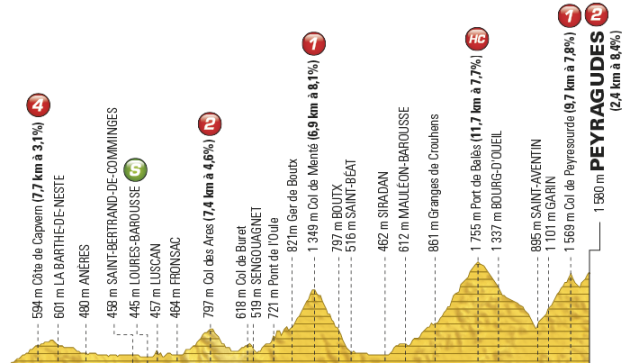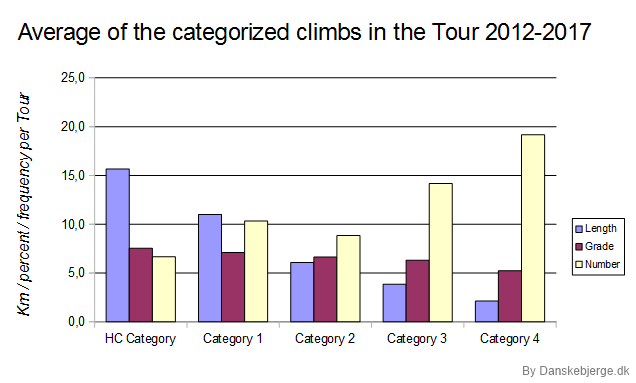
|
|
|
WHAT HAS HAPPENED TO THE CLIMBS IN THE 2017 TOUR ? THE FULL VERSION Any Tour de France fan will be looking forward to the mountains. Essentially, it is in the mountains that the race heats up, and decisive minutes can be won or lost in the general classication. And yet, a mountain is more than just a mountain. Having gathered data from several Tours in recent years, I will here try to provide an insight into the nature of the French climbs and their categories. When the riders of the Tour de France enter Paris on the 23rd of July, they will have enjured 3540 kilometers and not least: 53 categorized climbs. The climbs will undoubtedly create a fair deal of drama. And they will have significant influence on who will win stages and finish in the top of the general classification. I guess that's why so many of us find these elements of bike races so intriguing. But what are the fundamental characteristics of the climbs of the Tour de France? And is there anything particular about this year's climbs compared to previous editions of the race? That's what I will look into in this article which - just to warn you - will contain quite a few numbers! [Bored? Go to the summary of this article here.] Mountains are often just hills Firstly, it should be stressed that the concept of "climbs" covers a wide range of road sections with rising terrain. The Tour de France may often be associated with mountains, but not all Tour climbs are mountains in its plain definition. On the contrary. Take stage 2 as an example - the first regular road racing stage of the Tour. The stage, going from Düsseldorf to Liège, has two categorized climbs. They are both a little less than 1.5 kilometers in length and ascending by a little less than 5 percent in average. Which is far from frightening. Even in my home country Denmark - in which there are no real mountains -, we have several climbs tougher than those two. And yet, they are a part of the Tour de France, and there are good reasons for it. First and foremost, they are intended to start the battle for the polka-dot jersey. And they are there to tempt the offensive riders - because even modest hills can often make a difference if somebody wants to break away from a large group. And basically, that is how you should perceive route elements of this sort: While they will hardly contribute to decide who will eventually be standing on the top of the podium in Paris, they do have a potentially big influence on how each stage will develop.
Considerable differences The Tour organizers have placed the two mentioned climbs in the category called category 4. This is the easiest category of climbs. It is also the most numerous. 16 category 4-climbs are represented in this year's Tour. The shortest of them is just 1.1 kilometers long (Côte de Villers-la-Montagne, stage 3). The longest is seven times longer: 7.7 kilometers (Côte de Capvern, stage 12). In other words, category 4-climbs can be quite diverse. But that goes for all climb categories in the Tour. There is a big span in both length and steepness, and if you are looking for an official definition of the categories, you are not going to find it. Insisting on finding regularities among the categorized Tour climbs, I began some years ago to gather data about them. In turn, the material has become pretty extensive and now comprise 596 climbs. The climbs belong to two periods: The years 2006-2009 and 2012-2017, i.e. from a total of ten editions of the Tour de France. The examination of categorized climbs from the last six years shows for instance that · the shortest is 0.7 kilometers long (a categori 4-climb in 2012) · the longest is 34 kilometers long (a category 1-climb in 2014) · the least steep climb slopes by 2.9% in average (category 4-climb in 2014) · the steepest climb slopes 10.8% in average (category 4-climb in 2014) Defining averages The numbers also show - hardly surprising - that when a climb is particularly long, short, steep or easy, it almost always has a parameter drawing in the other direction. Meaning that very long climbs are rather flat, too, while very short climbs are correspondingly very steep. If you take all 355 categorized climbs in the mentioned period, you will end up with an average climb that is - so to say - just as long as it is steep: It is 5.3 kilometers long and has a slope of 5.3 in average. In the diagram accompanying this article, you can see average values for each of the five categories in the Tour de France 2012-2017. And what else can we use these collected numerical values for? Few big climbs Well, first and foremost they can help us put each year's Tour into perspective. Comparisons between long term averages and data about the climbs of, say, the 2017 edition of Tour de France can show if these climbs distinguish themselves from earlier. This year, you can't avoid noticing that there are less categorized climbs than usual. 53 climbs versus an average of 59. That indicates a less mountainous Tour even though the categorized climbs don't account for all vertical meters of the stages. The distribution of climbs in the five categories is close to standard practice. There are 7 HC-climbs (like in an average Tour), 11 climbs in category 1 (one more than average), 5 climbs in category 2 (4 less than average), 14 climbs in category 3 (like the average) and 16 climbs in category 4 (3 less than average).
Regarding category 2, I keep wondering why the number of climbs in that category is so low. It is the same thing basically every year - for some reason it is a neglected category. And it ruins the system of "the easier a category, the shorter, flatter and more frequent the climbs will be". Category 2 is messed up, and I can't help thinking we could easily do without it. Anyway, we'll just leave that consideration to Mr Prudhomme. Let's instead again turn to the particular characteristics of the climbs of 2017. Long and steep? Most of all I found that in four out of the five categories, the climbs are shorter than normal. For example the HC climbs and the category 1-climbs are in average about two kilometers shorter than what has been typical for the Tour since 2012. That does to some extent accord with the general tendency going back to the '00s: that the Tour climbs have become shorter and steeper. A development which has favored a more aggressively ridden contest rather than a grueling, but also somewhat predictable mountain race. This year, however, the percentages have not risen accordingly. The climbs have just become shorter - not steeper. Combined with the fact that the number of climbs is unusually low, the picutre of a not particularly mountainous Tour de France 2017 seems irrefutable. Boring! some might say. To which the reply could sound: well, it depends on how the riders will approach the race. One more factor, though, is worth taking a look at: The placement of the climbs. Typical climbs For often, it is not the tough terrain of the entire stages which is decisive for the end result of a Grand Tour. A more important issue is how the last sections of the routes have been designed. Traditionally, cycling fans have judged the Grand Tours from the frequency of uphill finishes. The classic finish is the one on the Alpe d'Huez where the ascent goes on and on all the way to the top, and where the riders cross the finish line one by one. Alpe d'Huez is not part of this year's Tour, and in fact, there are only two stage finishes of this type. That is on stage 5 (La Planche des Belles Filles, category 1) and on stage 18 (Col d'Izoard, HC). However, it would be misleading to divide all stage finishes into those finishing uphill and those that don't. Especially in recent years, race organizers have realized that the last 10-20 kilometers towards the finish line can be put together in various ways. And that a long, tough climb up to kilometer zero might not be the only - and perhaps even not the best - solution if you want to prepare the ground for high-drama racing. Olympic recipe Last year's olympic route in Rio is an example of the "new" way to make route finishes. The hardest climb of the route was not placed at the end. It peaked at around 15 kilometers from the finish. That meant, on the one hand, that an uphill attack could lead to victory. On the other hand, it also meant that the race wasn't decided, just because a gap was created at the top of the mountain. The leading rider still had to push hard on his way down and on the closing flat section. As we know, a crash on the difficult descent turned the battle for medals upside down, with the pursuers suddenly finding themselves at the very front of the race. The 2017 edition of the Tour de France has no "olympic finishes" to offer. But a handful of stages do hold potential for unpredictable drama. Especially stage 12 has an interesting height profile on the ultimate kilometers: 15 kilometers from the finish a category 1-climb begins, then there is a short downhill section, and it all finds its conclusion on a short category 2-climb to the finish line. That will be fun, I'm sure. (See the stage 12 profile above.) The 8th stage has a category 1-climb on which the peak is reached 12 kilometers from the finish, and then an undulated stretch must be overcome at the end. On stage 14 we find an uncategorized and yet solid climb with around 15 kilometers to go - another example of a route where the potential for exciting developments is spread out to a fairly long section towards the finish instead of being all concentrated on an Alpe d'Huez-like mountain. The hunt for seconds I doubt that the alternative stage finishes are going to offer opportunities to gain several minutes in the classification. But in an edition of the Tour de France where the big mountains take a back seat, the riders must focus on the small wins that are available from stage to stage. This is what makes the Tour 2017 fairly difficult to predict. For the same reason, I expect a tight classification where fortune and misfortune have a big impact on who will be standing on the podium in the French capital. You'll find more analyses here: · The climbs 2017 - A summary · The climbs 2016 - Ten years of Tour climbs, what has changed? · The climbs 2015 - Looking for new trends · The climbs 2014 - Climbs changing: Steeper and shorter More: About Danskebjerge.dk 10 tough Danish climbs Records of the Danish landscape | ||||||||||||||||||||||||||||||||||||||||||||||||||||||||||||||||||||||||||||||||||||||||||||||||||||

